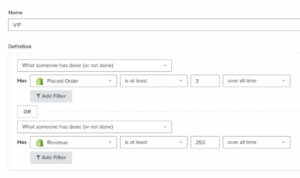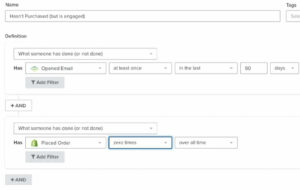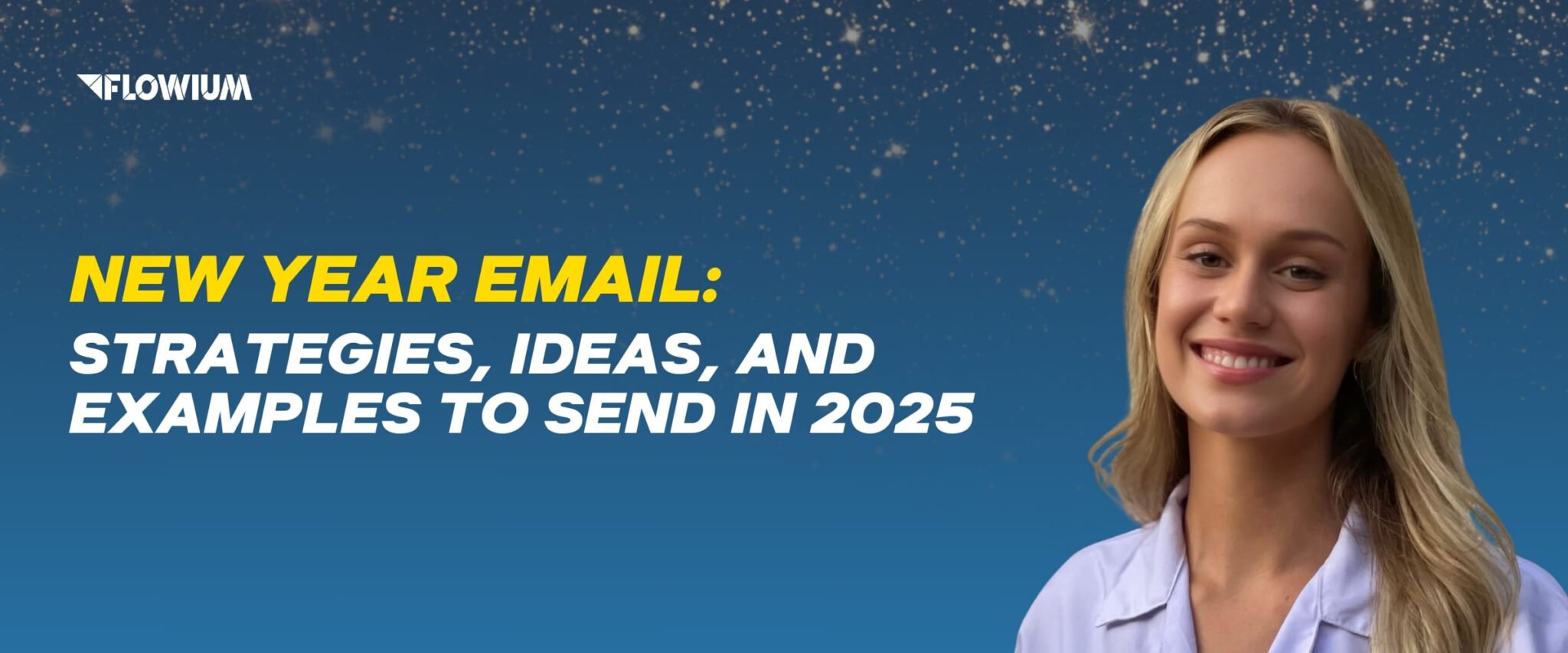I would like to talk about eight segments that you need to set up for any holidays season, but specifically for this Black Friday/Cyber Monday.
Black Friday is the single most important sale for any eCommerce brand. Check out our Black Friday checklist to make sure you have everything ready for the big day.
Recently, we released a podcast episode, it was episode 64, where Alissa and Vira were talking about the four segments you need to set out, and I just want to expand on that podcast because I believe we need to add more.
They cover the four segments that I will include in my eight in greater detail, but I will give you just overall view of things that you need to do. Okay, so let’s start.
1. Master Segment
Segment number one is the master segment. Again, this kind of segment you need to have all the time, not only for holiday season, but specifically for holiday season, I will explain why.
One of the most common mistakes we see with our clients and potential clients, or some accounts where we do audit, is people are blasting campaigns to their entire list.

So this master segment is your entire list of all active subscribers. People who you can send marketing email to so they are not unsubscribed, they’re not bounced, they are not suppressed and so forth.
It sounds like I’m contradicting myself so we need the segment, but we are not allowed to send to the entire list.
We highly recommend not to send to the entire list. However, on big promotions, like Black Friday, Cyber Monday, Christmas, New Year, whatever is your biggest promotion, you should send at least once to your entire database.
Any other reason, do not do that. It’s a very, very bad practice. However, when you have the highest promo in the year for your store, then you should send to the entire list. So this is segment number one, master segment.
2. Engaged Segment
Segment number two, it’s your engaged segment, and this should be the segment of all of your engaged subscribers. Engagement segment is anybody who opened any of your email in the last X number of days. And by X, we mean, it is different for brand.
We typically start from 90 days. So anybody who opened your email in the last 90 days, and then we either decrease or increase the number of days.
So giving you example, let’s say you send it to engaged list, and your engaged list is anybody who opened your email in the last 90 days. And let’s assume your open rate is through the roof, like 50% open rate.

It means that you should expand your engaged segment. So from 90 days, you should expand to 120 days, 150 days, 180 days. So increment of 15 to 30 days.
However, on the other hand, if you send your campaign and you’ve got 10% open rate, so below 20% open rate, you should shrink your engaged segment to maybe 60 days, 70 days, 50 days.
The goal is to be 20% or above. Preferably… Actually, bring your standard a little bit higher and try to be at 25% or higher. And just keep in mind, exclude any and all Apple mail.
Because after the new release of iOS, anything you send to Apple, it will be considered a hundred percent open, so it might screw up your general matches.
So this was segment number two, which is engaged. And by the way, you should have this segment, by the fall, all the time, not only for the holiday season.
3. VIP Customers
Segment number three is VIP customers, your very important customers, very important people. Why? Because they probably drives majority of your revenue.
So how do we define VIPs? Again, it depends on the brand, but general rule of thumb is if they place an order three plus time in your store, or maybe they place an order only once or two times, but their total order value is three times of your average order value.

What I mean, so let’s say your average order value is $50, and this person placed an order only once but placed an order for $150, it means three X of your average order value and this person you can consider as VIP.
You can make standard higher for VIP. You can do it four X, so four purchases or four X of the average order value. But I do not recommend to go lower than three.
4. Hasn’t Purchased But Engaged
So segment number four is they have not purchased yet, but they are engaged. So here, we need two sets of definitions. So first is they place an order zero times overall, so they never purchase from you.

But the second definition is they opened any of your emails in the last X number of days. And that X number of days, 96 to 120, will be defined based on your engaged segment that we previously discussed in segment number two.
5. Gift Givers
Segment number five is gift givers. So this is specifically for the holiday season. I love how Alissa explained on the podcast how Gap does it for their sub-brand or the other brand they have, Athleta,
I believe, how they treat gift givers better than their actual customers. So how to set up this segment, if you have the gift cards, so anybody who purchased gift cards in the past, so this is one way to segment them out.
And second way, maybe you have some brand two options to include gift message, gift message with the purchase. So maybe you have a box where you said, “Is it gift?” Yes, and include gift message.
So these are two definitions on how you can segment out those gift givers and send them specific campaigns, telling them, “Hey, you purchased gifts from us before for X, Y, and Z person.
You should hear what we have anew for this year.” This is like, new changes, new discounts, or especially for you, like 20% off, or something.
You can be creative with this, but basically you should target those kind of customers with different kind of message, more personalized. And keep in mind, they are buying for somebody else, and not for themselves.
6. Holiday Shoppers
So next segment is holiday shoppers. Holiday shoppers is anybody who placed in the order last year during your holiday promo. If your store is new, just skip it. Or actually, set up for this year, so you’ll have it useful for the next year.

But if you are more than one year in business, you should set up this segment. So basically, you need to set up a segment for anybody who placed an order last year between one date and another date when you had this sale.
So just give an example. So November, let’s say, you had it November 15th, you started your promo sales, and November 30th was the last day when you run the sale.
So you need to create anybody who placed order at least once between dates, November 15, 2020 and November 30th, 2020 and this is your shoppers.
Actually, those are your hot leads who you should target because they purchased last year during this period time, and they are more likely to buy this year during the same holiday period.
7. Non-Holiday Buyers
The next segment is this year non-holiday buyers. This segment we need to set up, so we can target again and again these kind of people who did not take you up on your offer, who did not use your promo code, they did not use your promo.
So we want to create this segment so we can hit them over and over and over with the messaging this year, this holiday season, to buy from you, to use your promo, or whatever promotion you do. You should always include this segment in your promo campaigns.
8. Non-Openers
And the last one is non-openers. I will explain to you the general idea of this segment, but you might create many variations of the segment.
So for example, let’s say today is Black Friday, Cyber Monday, and you want to send in the AM, in the morning, one email in the evening, one email, and let’s say closing the sale, let’s say 10:00 PM, 10 in the evening.
What you want to do, you want to create the segment of people who did not open the morning email so you can hit them in the evening. And later, the last email you want to send in the evening, to everybody who did not open, let’s say, the first email, or second email, or both of them.
So these non-opener emails, you should either refresh every time, or recreate and have many variations of it. And after the holiday season, you can just delete them.
So the setup should be, the definition of the segment is, have received X, Y, and Z email, but did not open X, Y, and Z email.
So those were eight segments you should prepare for holiday season to be ready. So after you download those segments, there’s not much to do, just include the correct segment when you send a campaign, and exclude correct segment when you send a campaign.
Setting up your Klaviyo account can be tricky. That’s why we created a Klaviyo Setup Checklist – so you don’t miss any important steps in the setup process.
In case you have any additional questions, feel free to leave them under this video. By the way, I’m testing a new format of video, so that’s why I’m driving my car, just to be a little bit more efficient.
Just provide your feedback if you like it or don’t like it. Thank you







